Exhibit 99.1
Welcome to AMAG Analyst Day 2016 AMAG Analyst Day 2016

AMAG Management Team Bill Heiden Chief Executive Officer Julie Krop, M.D. Chief Medical Officer Nik Grund Chief Commercial Officer Frank Thomas President & Chief Operating Officer Ted Myles Chief Financial Officer Todd Van Horn General Manager, CBR Melissa Klug SVP, Business Development & Strategy 2

3 Agenda – AMAG Analyst Day 2016 (8:30 AM – 12:00 PM) Registration and continental breakfast Welcome & agenda Linda Lennox, VP, Investor Relations Strategic overview & outlook Bill Heiden, CEO Makena franchise Nik Grund, CCO Julie Krop, CMO Makena Q&A Cord Blood Registry Todd Van Horn, CBR General Manager CBR Q&A Severe preeclampsia option (Velo) Julie Krop, CMO Panel of 3 outside experts Moderated by Frank Thomas, President & COO Feraheme Nik Grund, CCO Julie Krop, CMO Feraheme Q&A Business development strategy Frank Thomas, President & COO Financial strategy and guidance Ted Myles, CFO Closing Remarks and Q&A AMAG executive team - led by Bill Heiden, CEO

Forward-Looking Statements This presentation contains forward-looking statements within the meaning of the Private Securities Litigation Reform Act of 1995 and other federal securities laws. Any statements contained herein which do not describe historical facts, including among others, statements regarding the future market opportunity and growth drivers for Makena, including a new partnership with a provider of home nursing services, share gains from compounders, formulary expansions, the impact of the increased size of the sales force and support services and their effect on physician and patient brand loyalty; expectations for the single-dose formulation of Makena, including its benefits, launch strategy, positive indicators on Makena growth after the commercial launch of the single-dose formulation of Makena and estimated prescriptions; expectations for the Makena subcutaneous auto-injector, including estimated revenue, expectations of improved patient care, its development and advantages, estimated filing timeline of the sNDA and FDA review period and potential extension of orphan drug exclusivity; the future market opportunity and growth drivers for CBR, including expanded market penetration and the impact of a shift in value proposition and of connecting to the research community; expectations regarding the severe preeclampsia candidate, including the timing of initiation of a Phase 2b/3a study, potential orphan drug exclusivity, the future market opportunity and the impact on the Company’s portfolio and position in the maternal health market; the future market opportunity and growth drivers for Feraheme, including plans to grow market share in the hospital and hematology/oncology segments; plans and expectations, including the size, timing of data and potential commercial launch of the head-to-head Phase 3 clinical trial for the broad IDA indication for Feraheme and the potential increase in size of the addressable market for Feraheme; 2016 financial guidance, including revenues, adjusted EBITDA, net income and cash flow; expectations regarding near and long-term intentions related to debt, equity and cash on hand; and AMAG’s key milestones, including plans to achieve commercial, clinical, financial and portfolio expansion objectives are forward-looking statements which involve risks and uncertainties that could cause actual results to differ materially from those discussed in such forward-looking statements. Such risks and uncertainties include, among others, those risks identified in AMAG’s filings with the U.S. Securities and Exchange Commission (SEC), including its Annual Report on Form 10-K for the year ended December 31, 2015, its Quarterly Report on Form 10-Q for the quarter ended March 31, 2016 and subsequent filings with the SEC. Any of the above risks and uncertainties could materially and adversely affect AMAG’s results of operations, its profitability and its cash flows, which would, in turn, have a significant and adverse impact on AMAG’s stock price. Use of the term “including” in this paragraph shall mean in each case “including, but not limited to.” AMAG cautions you not to place undue reliance on any forward-looking statements, which speak only as of the date they are made. 4
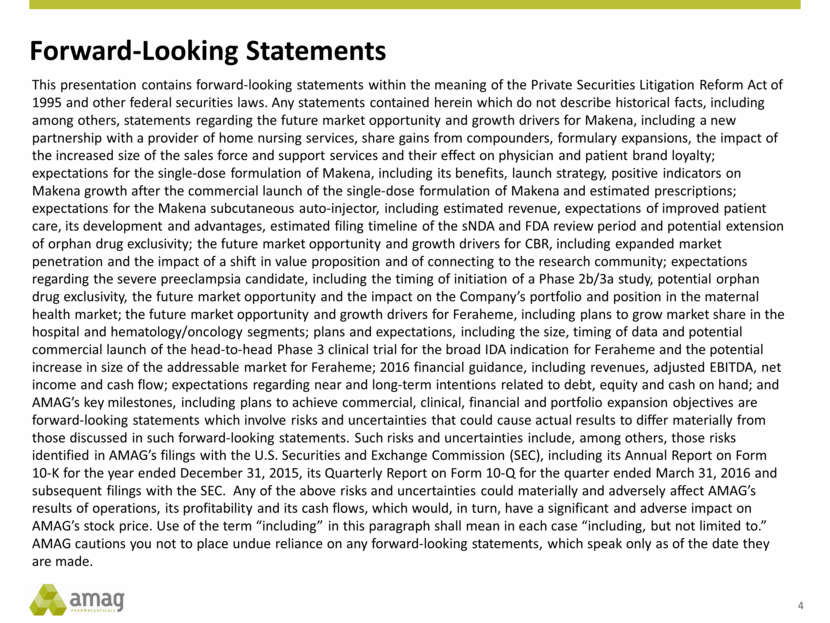
Strategic Overview & Outlook Bill Heiden Chief Executive Officer AMAG Analyst Day 2016
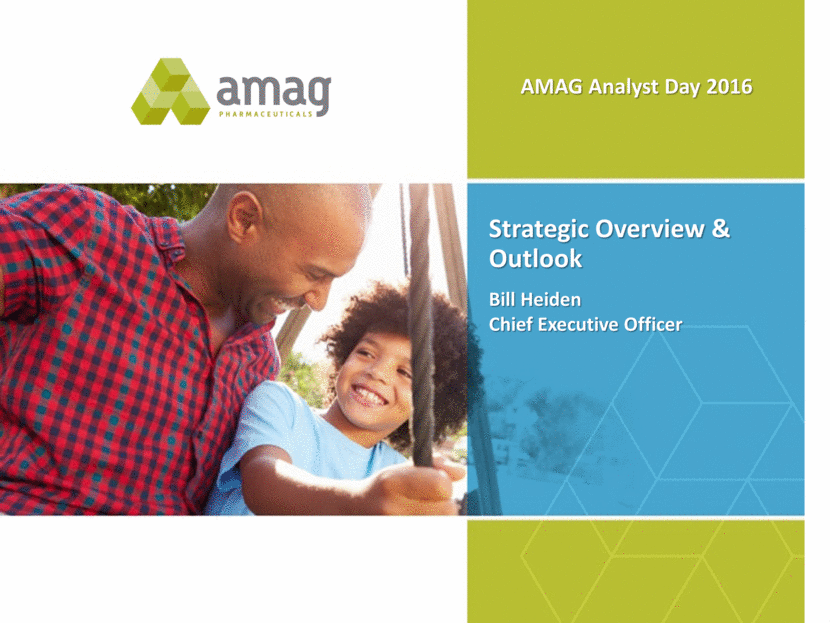
THE AMAG STORY – AGENDA Building a Growth-Oriented Biopharma Company AMAG Today Two Strong Platforms Multiple Growth Drivers 6

AT A GLANCE AMAG Today: Diversified and Financially Strong Hematology/ Oncology Business Maternal Health Business Feraheme & MuGard Cord Blood Registry Makena Marketed products Market cap Cash & investments Total net leverage ratio2 Employees 4 ~$809M $480M ~2.6x ~600 2016 Forecasted Product Revenue of $545M1 Key Facts: (March 31, 2016) Reflects midpoint of AMAG’s 2016 total product revenue guidance. Debt minus cash divided by LTM adjusted EBITDA ($1,041M-$480M/$214M) 7

A Transformed Company From: A single product company in 2012 Feraheme Operating loss 8

9 A Transformed Company To: A biopharma company with a portfolio of differentiated growth products Strong Cash Flow High-Value Therapeutic Platforms Growing / Profitable Diversified Portfolio Acquisitive

Last 18 Months – Significant Progress Drove Makena business expansion 2015 expanded access, enlarged sales team, gained market share, Q1-2016 sales up 17% FDA approved single-dose, preservative-free formulation Launched Grew Feraheme business Returned to double digit growth in 2016; sales up 13% in Q1-2016 Completed and integrated acquisitions Makena, Cord Blood Registry, combined sales teams Option to acquire rights to orphan drug candidate for treatment of severe preeclampsia (Velo) Strengthened management team Chief Medical Officer (June 2015) Chief Commercial Officer (January 2016) Chief Financial Officer (April 2016) 10

Growing, Cash Generating Business Model Will Fuel Long-Term Growth Solid organic growth trajectory through consistent commercial excellence High margins, low capex Fund acquisition & development of high quality new products Strong cash flow from operations >$200M in 2016 Strong Q1-2016 balance sheet: $480M cash & investments, low net leverage ratio 3 4 2 1 11

THE AMAG STORY – AGENDA Building a Growth-Oriented Biopharma Company AMAG Today Two Strong Platforms Multiple Growth Drivers 12

Building on Two Strong Platforms Growth-Oriented Biopharmaceutical Company • Financial Strength • Corporate Infrastructure • Commercial & Digital Expertise Maternal Health Business Hematology / Oncology and Hospital Business ~78% of revenues Products: Makena CBR Severe preeclampsia option (Velo) ~22% of revenues Products: Feraheme MuGard 13
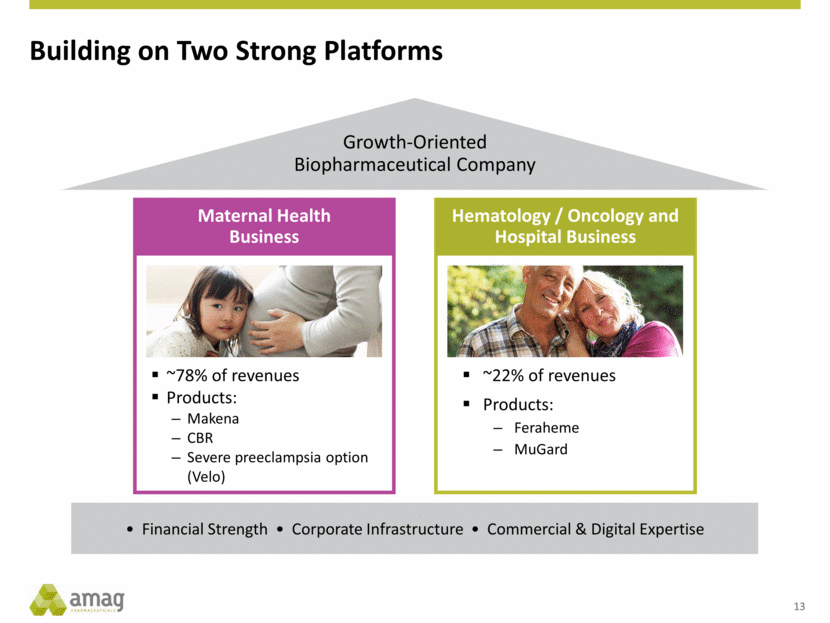
Revenue Proven Capabilities Enhancing commercial & Medicaid patient access Premium customer service - Makena Care Connection; educational programs Partnership with leading provider of home nursing services Partnerships with former compounders Optimization of sales force size Future Additional physician & patient support programs Developing next generation products Revenue Proven Capabilities Clear & compelling product differentiation: e.g. “Easy as 1-2-3” Optimizing pricing & contracting strategies Growing hospital segment Future Potential label expansion Market expansion 14 Proven Commercial Execution Capabilities Consistently Maximize Product Growth Opportunities Next up

THE AMAG STORY – AGENDA Building a Growth-Oriented Biopharma Company AMAG Today Two Strong Platforms Multiple Growth Drivers 15

Ambitious Future Growth Plan Key Plan Pillars GROWING: Organic growth of current products through excellence in execution and ability to leverage key strengths and differentiators to expand use BUILDING: Disciplined, patient-centric approach to portfolio expansion that complements our current strengths and differentiators TOGETHER: Continued development of a best-in-class workforce with a strong, unified culture through investment in infrastructure and people 16
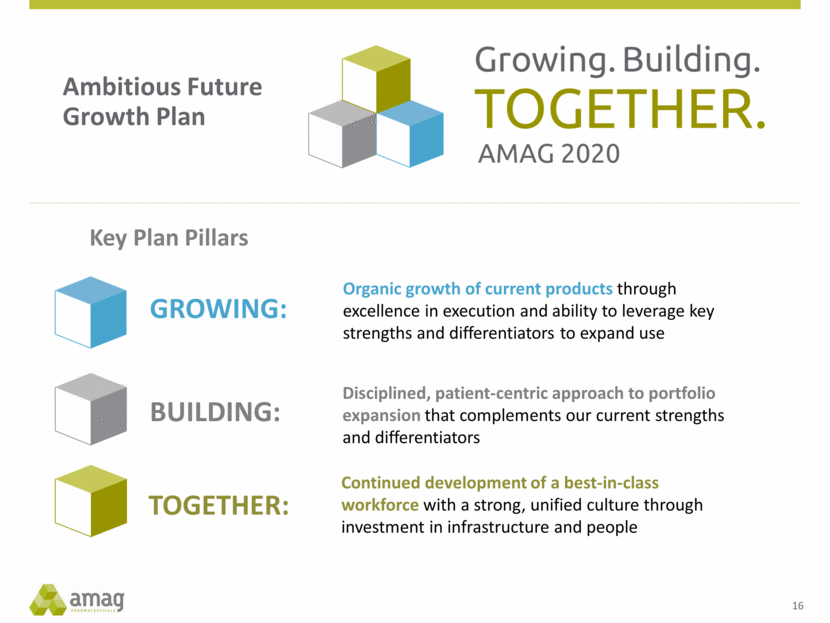
GOING FORWARD Multiple, Growing Revenue Streams Business Development Feraheme & MuGard CBR Makena Time 17 Velo $

Makena Commercial Strategy & Outlook Nik Grund Chief Commercial Officer AMAG Analyst Day 2016

Makena Agenda Status today – building on two strong foundational platforms Market opportunities Competitive landscape Next generation development 19

Building on Two Strong Platforms Growth-Oriented Biopharmaceutical Company • Financial Strength • Commercial Expertise • Corporate Infrastructure Maternal Health Business Hematology / Oncology and Hospital Business ~78% of revenues Products: Makena CBR Velo option ~22% of revenues Products: Feraheme MuGard 20

Makena Agenda Status today – building on two strong foundational platforms Market opportunities Competitive landscape Next generation development 21
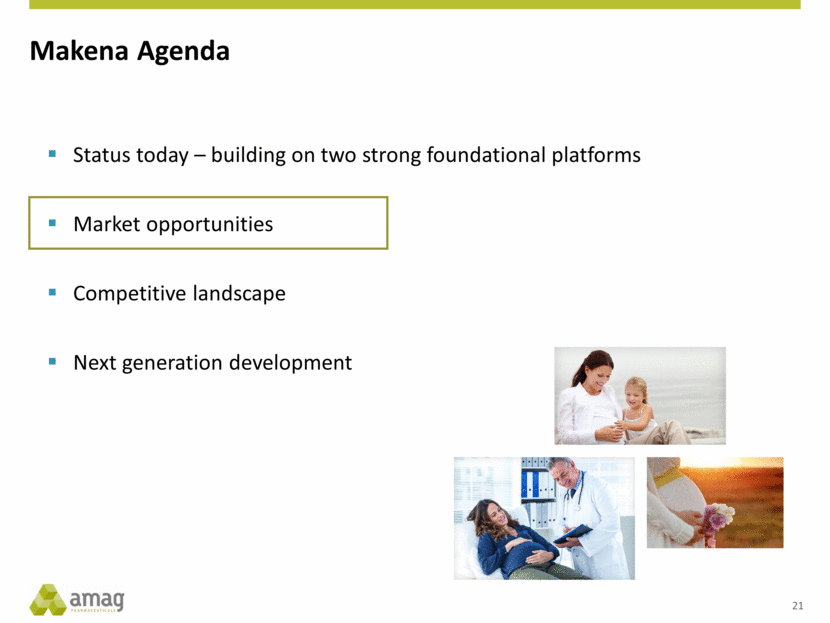
New partnership with a leading provider of home nursing services One of the largest former sources of compounded Makena Continued market share gains from compounders Preservative-free launch could expand conversion of additional compounding pharmacies to Makena distributors Continue to pull through formulary expansions Maternal health sales force increased to 104 reps from 76 reps (+37%) in Q3-2015 Target physician base doubled to 16,000 OB/GYNs Enhance physician and patient brand loyalty with valued support services, such as Makena Care Connection and nurse-supported adherence program Growth Drivers in 2016 and Beyond Compounded Hydroxyprogesterone Caproate2 Makena2 Off Guidance3 $1B Market Opportunity1 Q1-2016 market share 22 Based on 140,000 patients, >16 injections/patient and net revenue of ~$425/injection. Company estimates Makena market share based on distributor dispensing data and all other market share estimates based on physician market research data conducted by AMAG. Off-guidance represents patients treated outside guidance of Society for Maternal Fetal Medicine (SMFM), including patients treated with unapproved therapies and untreated patients. 30% 37% 33%

Single-Dose Makena: Gain Share and Convert Market Preservative free Convenient for healthcare providers (HCPs) 4-pack aligns with insurers’ policies Benefits of Single-Dose Vial of Makena Priority #1: GROW HCPs who prescribe compounded IM HPC (Includes home healthcare opportunity) Priority #2: PROTECT HCPs who prescribe multi-dose Makena Launch Strategy Convert ALL prescribers to single-dose Makena (new and current prescribers) 23

Single-Dose Execution Priorities Market Access Team Contracting under both medical & pharmacy benefit Reducing access barriers Ramped up staffing to process Rxs Access Field Sales Converting physicians from compounded HPC Adding new prescribers Leveraging home health opportunities Expanding former compounding distributor network Demand Distribution Team Channel Expansion Adding new partners >50 Compounded product more difficult to acquire Distribution 24
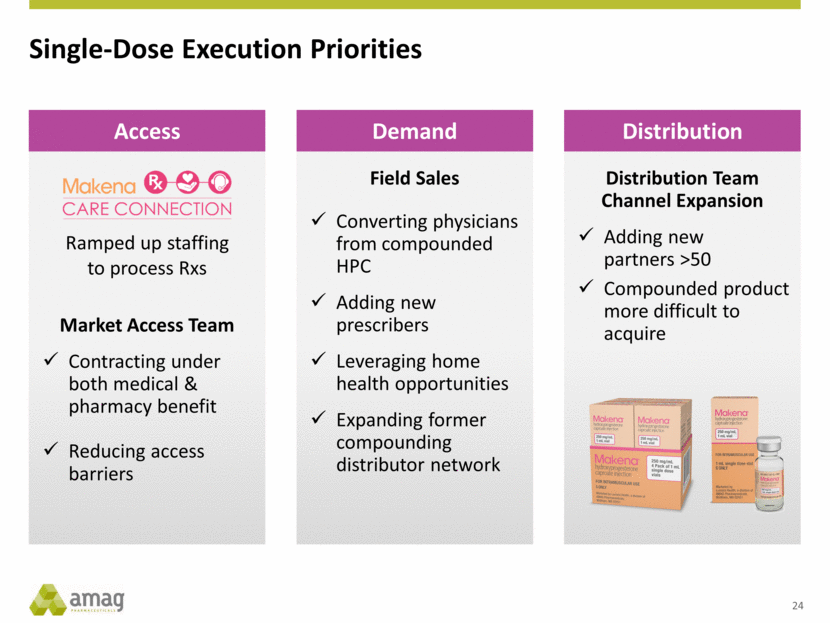
Makena Revenue Lags Enrollment by ~1-4 Months Rx’s Received in Makena Care Connection (Estimates) (Actuals) Increase in Rx’s driven by single-dose vial launch Estimated 2016 Makena Revenue ($M) % of Revenue From Prior Quarter Enrollments Current Quarter Enrollments Prior Quarter Enrollments 2 Quarters Prior Enrollments 25

Why We are Confident in the Long-Term Future of the Makena Franchise Only FDA approved drug to reduce risk of preterm birth Minimal competitive pipeline activity ü 26

Why We are Confident in the Long-Term Future of the Makena Franchise Only FDA approved drug to reduce risk of preterm birth Minimal competitive pipeline activity ü Significant room to continue growing market share Gained 11 market share points since product acquired in November 2014 Vs. compounded 17P segment (esp. with single-dose vial launch) Vs. untreated or treated with vaginal progesterone ü 27
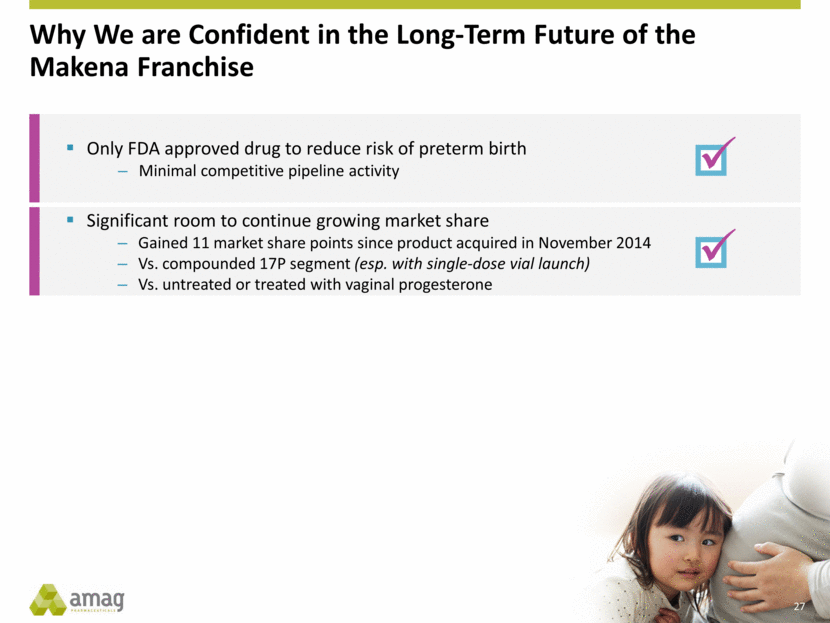
28 Interpretation Vaginal progesterone was not associated with reduced risk of preterm birth or composite neonatal adverse outcomes, and had no long-term benefit or harm on outcomes in children at 2 years of age.

Why We are Confident in the Long-Term Future of the Makena Franchise Only FDA approved drug to reduce risk of preterm birth Minimal competitive pipeline activity ü Significant room to continue growing market share Gained 11 market share points since product acquired in November 2014 Vs. compounded 17P segment (esp. with single-dose vial launch) Vs. untreated or treated with vaginal progesterone ü Opportunity to increase number of paid injections per patient From current average ~13.7 to a maximum of 16-18 paid injections ü 29
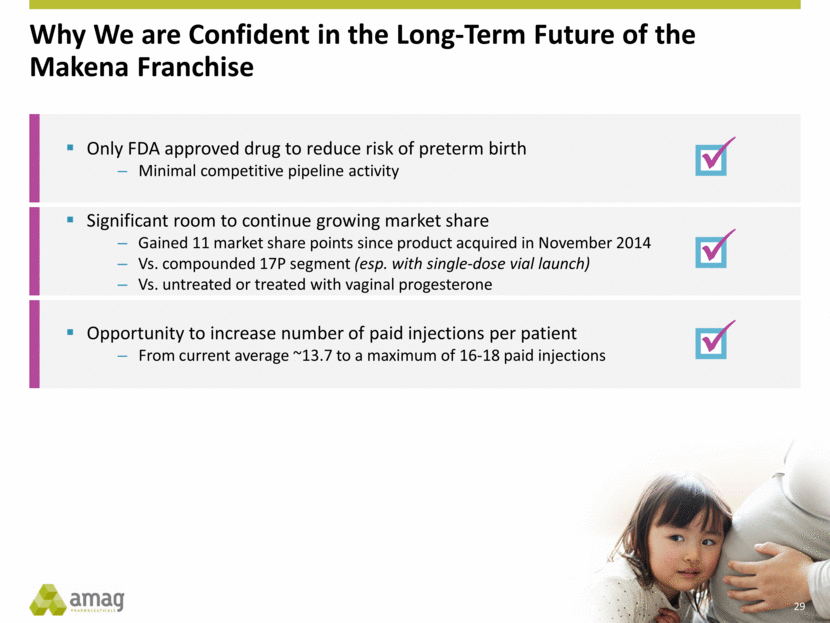
Why We are Confident in the Long-Term Future of the Makena Franchise Only FDA approved drug to reduce risk of preterm birth Minimal competitive pipeline activity ü Significant room to continue growing market share Gained 11 market share points since product acquired in November 2014 Vs. compounded 17P segment (esp. with single-dose vial launch) Vs. untreated or treated with vaginal progesterone ü Next generation Makena will drive 2018 growth and beyond Single-dose; subcutaneous auto injector ü Opportunity to increase number of paid injections per patient From current average ~13.7 to a maximum of 16-18 paid injections ü 30

Makena Agenda Status today – building on two strong foundational platforms Market opportunities Competitive landscape Next generation development 31

Competitive Landscape: Barriers for Generic Delalutin Label indication Limited ability to promote Risk of off-label use High-risk patient population Value proposition vs. compounded HPC Generic Delalutin Barriers to Use >100 sales representatives Makena Care Connection Broad distribution network Single-dose, preservative-free formulation Makena Business Model Advantages ü ü ü ü x x x x x 32
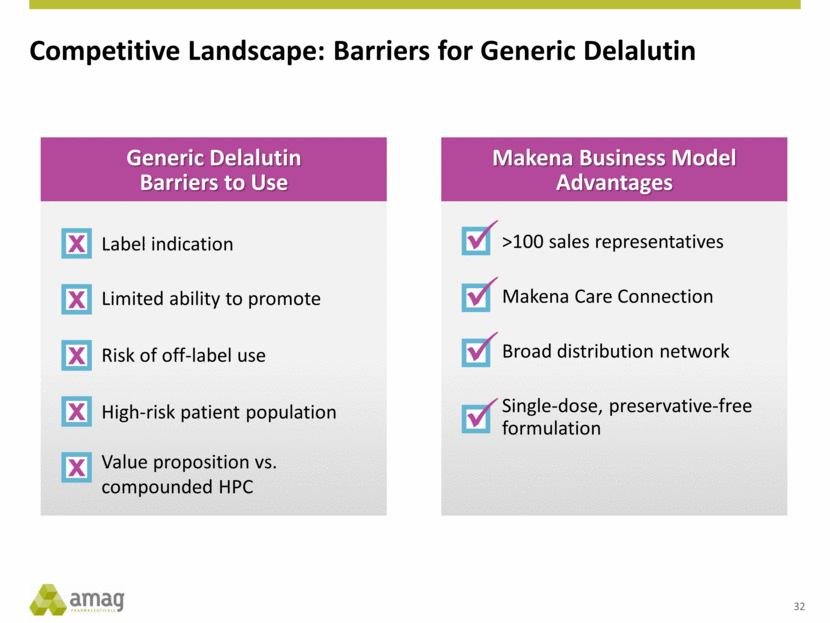
When C-HPC allowed, generic Delalutin may be duplicative or disadvantageous depending on price C-HPC Weakens Delalutin Value Prop. Makena is increasingly specialty pharma driven; Delalutin should follow suit Retail to be limited due to liability and waste Spec Pharma is King, Retail not Opportunity Select payers are thinking longer term and may wait to enact management until indicated generic entry Payers Also Awaiting Makena LOE Many plans would need clinical data and/or society backing to advantage Delalutin (e.g., Avastin in AMD) “I want to like this generic, but it comes down to dollars and cents vs. C-HPC.” Key Payer Perspectives on Future HPC Market “We’re putting ourselves at real risk without equivalence data or ACOG okay.” “Why would I not allow it to go through retail? I mean, why would I?!” “If Makena will be off patent in 2018, not sure it’s worth risk of managing now.” Competitive Landscape: Market Research1 on Durability of Makena Access Clinical Support for Generic is Key 33 1. Payer Interviews conducted by ClearView and sponsored by AMAG.

Makena Agenda Status today – building on two strong foundational platforms Market opportunities Competitive landscape Next generation development 34

Subcutaneous Auto-Injector Will Provide Significant Value to Makena Franchise – Pre or Post February 2018 Launch Estimated Base Case Revenue: Continued Sales Growth 2020 2015 Revenue Estimated Revenue with Launch Delay1: Even if Delayed, Franchise is Protected & Grows 2020 2015 February 3, 2018 Loss of exclusivity and potential launch of generics to multi-dose intramuscular product Revenue Approval of Makena auto-injector Availability of pain data February 3, 2018 Loss of exclusivity and potential launch of generics to multi-dose intramuscular product Approval of Makena auto-injector Availability of pain data Estimates based on analogues and market research conducted by AMAG with physicians and payers. 35

Makena Subcutaneous Development Pathway & Timeline Julie Krop, M.D. Chief Medical Officer & SVP, Clinical Development & Regulatory Affairs

Subcutaneous Auto-Injector Expected to Improve Patient Care Current Intramuscular (IM) Injections At-risk patients are treated weekly for approximately 5 months with a deep IM injection into the buttocks Subcutaneous (SC) Injections SC injection administered via auto-injector with shorter and smaller width needle Multiple studies have shown significantly less pain and higher patient preference for SC injections vs. IM injections Auto-injector easy to use – prefilled syringe, no needle contact 37
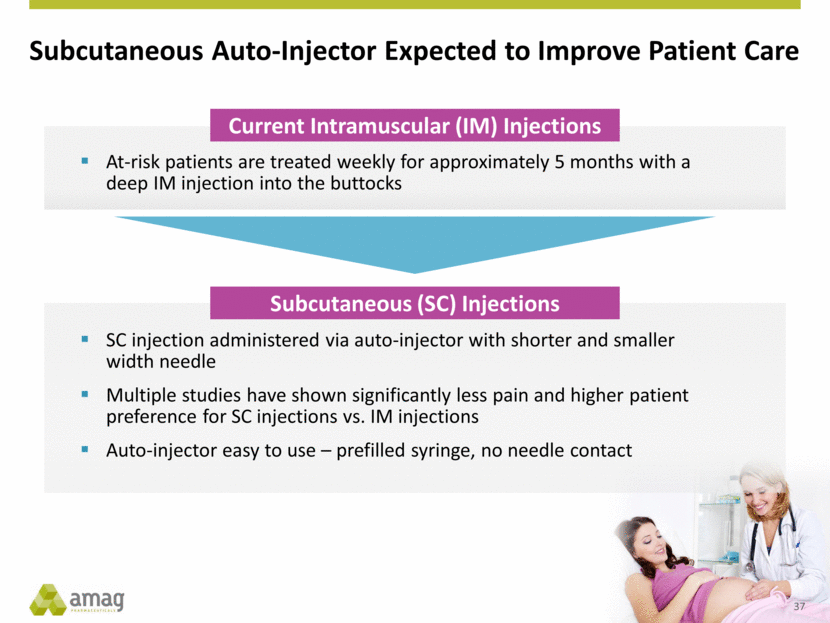
Injection Site Pain is Most Frequent Adverse Event of the Current IM Therapy Pain with Makena AND placebo: associated with injection, not drug Withdraw drug with 18G needle, switch to 21G needle for injection Slow injection due to high viscosity (up to 1 minute) Adverse Reactions Occurring in > 2% of IM Makena-Treated Subjects and at a Higher Rate than Control Subjects1 Preferred Term Makena N=310 % Control N=153 % Injection site pain 34.8 32.8 Injection site swelling 17.1 7.8 Viscous Oil-Based Vehicle Meis et al, NEJM June 12, 2003 38
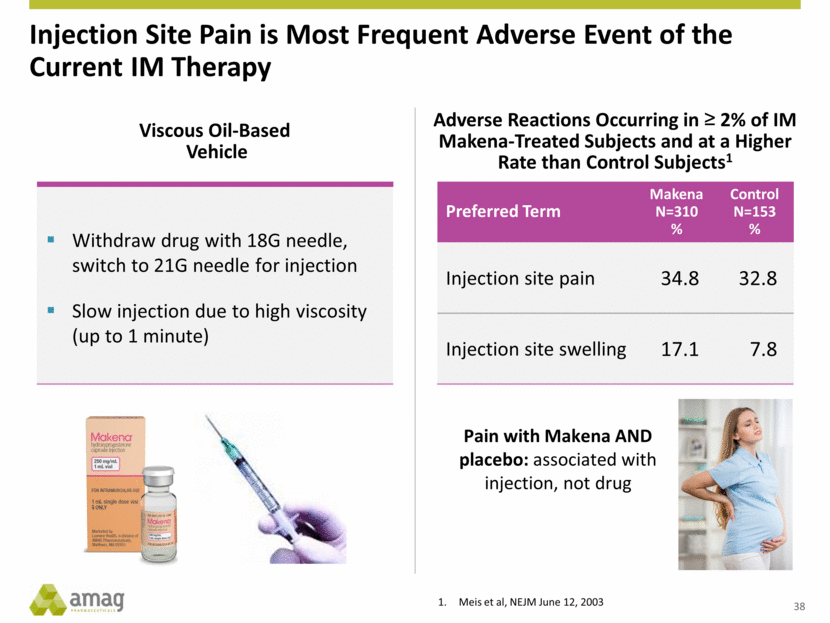
39 Several Studies Show Reduced Pain and Greater Preference for SC Injection over IM Injection Zackheim HS. Subcutaneous administration of methotrexate. J Am Acad Dermatol. 1992 Jun; 26(6):1008. Singham J, Greanya ED, Lau K, Erb SR, Partovi N, Yoshida EM. Efficacy of maintenance subcutaneous hepatitis B immune globulin (HBIG) post-transplant for prophylaxis against hepatitis B recurrence. Ann Hepatol. 2010 Apr-Jun; 9(2):166-71. Hahner S, Burger-Stritt S, Allolio B. Subcutaneous hydrocortisone administration for emergency use in adrenal insufficiency. Eur J Endocrinol. 2013 Aug; 169(2):147-54. Russo L, Moore WV. A comparison of subcutaneous and intramuscular administration of human growth hormone in the therapy of growth hormone deficiency. J Clin Endocrinol Metab. 1982 Nov;55(5):1003-6. Zackheim et al conducted study in patients on chronic IM Methotrexate and then switched them to SC injection1 SC injections were deemed less painful and easier to administer Hahner et al evaluated patient preference for SC vs. IM hydrocortisone3 92% of patients preferred SC over IM injections Russo and Moore compared patient acceptance of SC vs. IM growth hormone injections in a crossover study in children with growth hormone deficiency4 Overwhelming preference for SC route Several patients refused future therapy if it required IM injections Singham et al examined patient preference for SC vs. IM Hepatitis B immunoglobulin2 All patients preferred SC to IM 78% described SC route as much less painful

Unique Auto-Injector Proprietary auto-injector allows for SC administration of Makena Specifically designed for administration of viscous material through smaller needle - cannot pass Makena through small needle in the absence of device Utilizes shorter and more narrow 27 gauge needle Needle hidden from view - less anticipatory pain Prefilled, single use – “One & done” Current Injection Needle Subcutaneous Injector 40

Experienced Device Partner – Antares Pharma Leader in auto-injector development Proven track record – 4 drug device products FDA approved since 2012 Novel drug delivery technology Strong patent protection on device through 2026 41

pi 42 Advancing the Makena Auto-Injector Program Auto-injector Estimated FDA Approval H2-2017 File sNDA Q2-2017 Example of drug/device combo 2015 2016 2018 2017 2019 2020 Device dev/CMC & Pivotal PK Study February 3, 2018 Loss of orphan drug exclusivity

IN SUMMARY Makena: Building a Long-Life Franchise Executing next generation development program Easier to administer with potential for less painful injections Proven device partner, Antares Potential orphan exclusivity on drug/device combination if reduction in pain demonstrated Franchise longevity past February 2018 Example of drug/device combo 43

Makena Q&A

Cord Blood Registry (CBR) Todd Van Horn General Manager, CBR AMAG Analyst Day 2016

Agenda The Business Today Market Opportunity and Growth Drivers CBR’s Digital Consumer Platform 46

47 CBR is the Largest Newborn Stem Cell Bank and #1 Choice of Expectant Parents and OB/GYNs

CBR is a Leader in Consumer Health Science Consumers Providers CBR sits at the intersection of consumers, providers and science 48

CBR Educates Pregnant Mothers through Multiple Channels 49

CBR’s High-Margin Recurring Revenue Growth Drives Significant Value and Cash Flow New storages drive steady growth in high-margin recurring revenue stream <1% attrition of base supports high lifetime value of every new customer 8% CAGR All other annual storage fees New storage fees from prior year’s new enrollments Excludes new collection/processing revenues. 50 $50 M $75 M $100 M 2016 2017 2018 2019 2020 Illustrative Recurring Revenue Growth 1 (even if new enrollments only remain at 2015 level)

Agenda The Business Today Market Opportunity and Growth Drivers CBR’s Digital Consumer Platform 51

52 Primary Focus is Category Growth 4M Annual U.S. Births Shift message and pricing approach to capitalize on generational shift 1 Optimize product portfolio to address new segments of untapped market 2 Enhance and differentiate CBR’s offerings 3 Growth Drivers 95.0% 2.5% 2.5% Discarded Private Family Banking Donation

Prior Approach Key message with focus on mitigating risk for child Emphasis on technical aspects (e.g. cell recovery rates) of service Fear-based language Deep discount-driven, opaque pricing Message differed by channel Approach to digital communications and contact strategy broad and uniform Growth Strategy Key message of optimism for child with emphasis on investment in future Emphasis on reasons for preserving cells Future potential of regenerative medicine Minimal discounting and transparent and predictable pricing Single unified message tailored for each channel Digital approach augmented by predictive modeling and segmentation focused on driving consumer engagement in funnel GROWTH DRIVER #1 Shifting Value Proposition to Drive Growth 53 1

CBR is looking to augment/build on offering to clients in order to: Increase accessibility to new segments Maximize value of currently addressed segments Grow revenue and profitability in year one Further enhance long-term value of client 54 GROWTH DRIVER #2 Optimize Product Portfolio to Segment Market and Drive Category Growth Customer research and insights around generational shift and segmentation provides foundation to augment product portfolio. 2
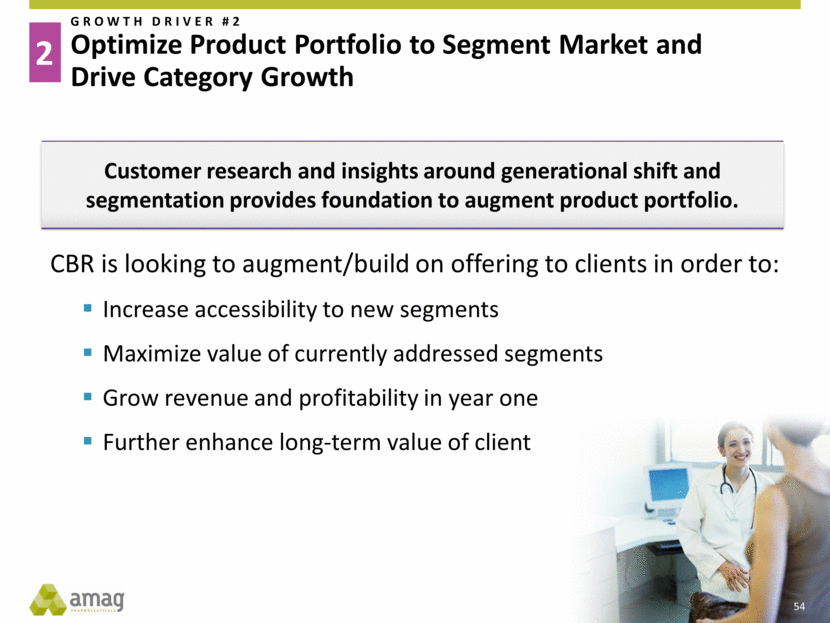
GROWTH DRIVER #3 Differentiating Our Offering and Leading the Effort to Connect Researchers and Our Client Families Child with: 1) Specific condition or injury + 2) Own newborn stem cells Researcher with: 1) Expertise in specific condition + 2) Interest in Cellular Therapy Newborn Possibilities Genetic Counselor Team Family Health Registry AMAG partners with institutions to drive research on newborn stem cells Hearing loss Cerebral Palsy Induced pluripotent stem cells (iPSCs) 55 3

Agenda The Business Today Market Opportunity and Growth Drivers CBR’s Digital Consumer Platform 56

LEVERAGE DIGITAL & CONSUMER PLATFORM ACROSS AMAG Digital Platform Drives Product Awareness and Consumer Engagement Email/Database Marketing Predictive modeling-based 2M+ leads per year Over 500,000 pregnant moms engaged Digital Properties Approximately 30% of enrollments from website More than 50% of traffic from mobile devices Sponsored content through partner sites Social Media Targeting of pregnant women Over 180,000 followers on Facebook with trend indicating growth Search Engine Marketing Critical component of digital strategy to optimize organic and paid search 57

IN SUMMARY Market Leader with Steady Cash Flow Growth and Upside Growth Potential Business model that drives steady, high-margin recurring revenue growth Substantial untapped market with multi-pronged strategy to address and grow CBR CBR’s digital platform and expertise will be leveraged across AMAG portfolio, which we believe is a competitive advantage for AMAG 58

Cord Blood Registry (CBR) Q&A AMAG Analyst Day 2016
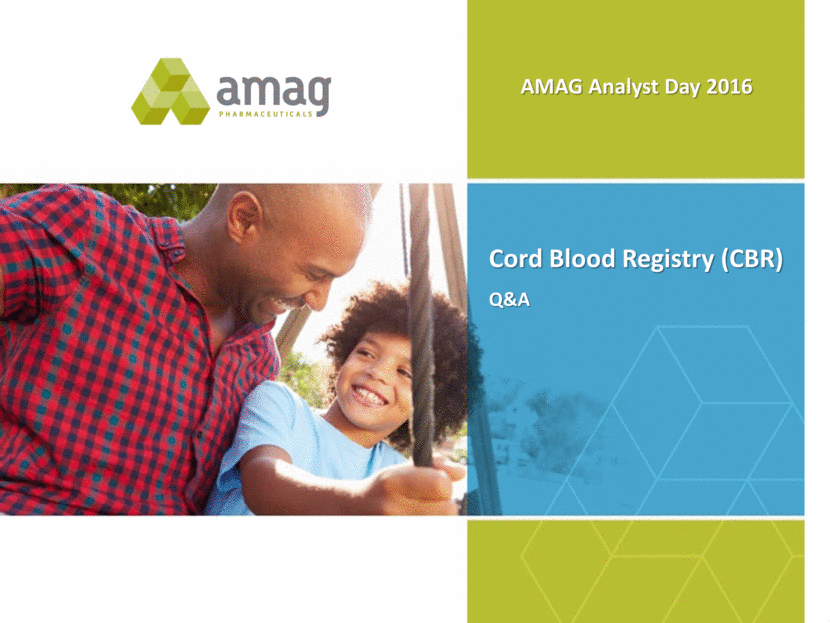
Severe Preeclampsia Candidate (Velo Option) Julie Krop, M.D. Chief Medical Officer & SVP, Clinical Development & Regulatory Affairs

Agenda Severe Preeclampsia (sPE) Candidate with High Unmet Medical Need Mechanism of Action, Prior Trial Results & Timeline Large Market Opportunity 61

Severe Preeclampsia Candidate: Exciting Opportunity Significant unmet medical need with large market potential Mid to late-stage development opportunity - Proof-of-principal clinical data - Velo to initiate Phase 2b/3a study by year-end Fast Track designation Patent protection and orphan drug exclusivity if approved Option deal structured to mitigate financial risk Small upfront cash payment of $10M in 2015 After completion of 2b/3a study, AMAG may exercise, extend or terminate option Expands product portfolio Strengthens leadership in Maternal Health 62

SEVERE PREECLAMPSIA High Unmet Medical Need Disorder of pregnancy associated with hypertension and end organ damage in the mother No “cure” other than delivery of the baby Current interventions only treat symptoms, not underlying pathophysiology Near term: Induction of labor is treatment of choice Earlier stage pregnancy: Attempts to delay delivery Associated with significant morbidity and mortality in the mother and baby Accounts for 15% of all premature deliveries1 Can lead to life threatening conditions: HELLP (Hemolysis, Elevated Liver enzymes, Low Platelet counts): 10%-20% preeclampsia cases 1 Pre-eclampsia Foundation; GOLDENBURG RL, ROUSE DJ. Prevention of premature birth. New England Journal of Medicine 1998; 339:313-20. 63

Agenda Severe Preeclampsia (sPE) Candidate with High Unmet Medical Need Mechanism of Action, Prior Trial Results & Timeline Large Market Opportunity 64
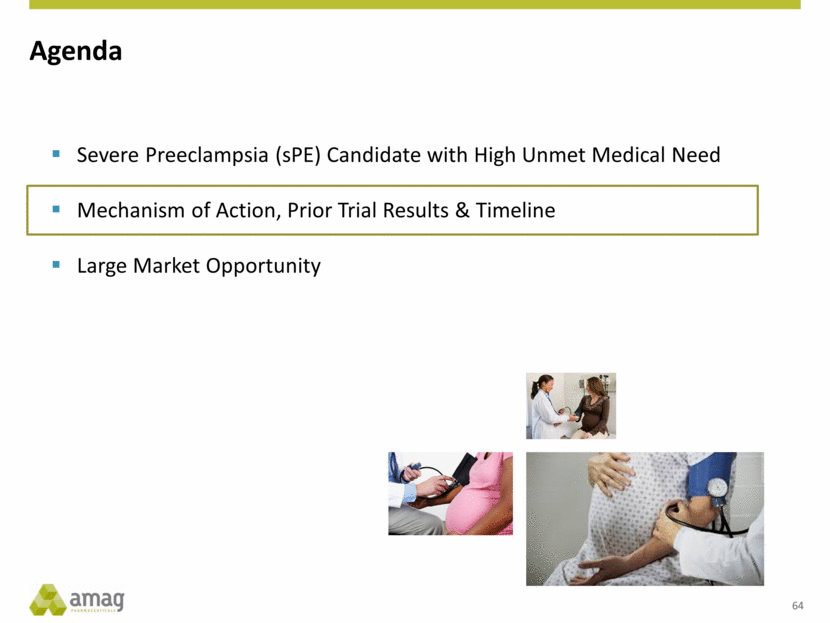
Pathophysiology of Severe Preeclampsia: EDLFs May Play Role Endogenous digitalis-like factors (EDLFs) have been recognized as key circulating factors that may be involved in preeclampsia EDLFs are increased in the circulation of majority of women with preeclampsia, and activity has been positively correlated with severity of preeclampsia EDLFs inhibit sodium pump at the cellular level leading to vasoconstriction and elevated blood pressure DIF is an antibody fragment developed as treatment for digoxin toxicity – marketed product for over 25 years Binds to digoxin preventing its effect Polyclonal antibody not specific for digoxin Also binds to EDLFs, blocking their activity 65

Proof-of-Concept Study (DEEP Trial)1 Placebo-controlled antepartum trial Study population (DIF n=24, placebo n=27) Severe PE (BP>160/90; evidence of end organ damage) 32 weeks gestational age Delivery required within 72 hours Two primary outcome measures: Change in creatinine clearance (statistically significant improvement) Use of antihypertensive drugs (no apparent effect) Pre-planned subset analysis of patients who were EDLF+ at baseline2 Adair CD, Buckalew VM, Graves SW, et al. Digoxin immune fab treatment for severe preeclampsia. Am J Perinatol. 2010;27:655-62. Lam GK et al, a secondary analysis of the DEEP Trial. American Journal of Obstetrics & Gynecology. August 2013, pp119.e1- 119.e6 66

DIF Inhibits EDLF Activity DIF significantly decreased EDLF activity (increased sodium pump function) Sodium pump activity was used to measure EDLF activity Majority of study subjects had EDLF activity at baseline (78%) No difference between groups at baseline Sodium pump activity improved with DIF N=21 30 25 20 15 10 5 0 -5 -10 N=19 N=15 N=22 N=21 N=20 N=12 % Change from baseline P=0.05 P=0.10 P=0.07 0-12h 12-24h 24-48h 24-48h (LOCF)* N=19 – DIF – Placebo Sodium Pump Activity1 Adair CD, Buckalew VM, Graves SW, et al. Digoxin immune fab treatment for severe preeclampsia. Am J Perinatol. 2010;27:655-62 * LOCF = Last Observation Carried Forward 67

68 Statistically Significant Preservation of Renal Function in DIF Treated Women1 DIF N=15 P=0.02 Placebo N=20 24-48h (LOCF) All Subjects 10 0 -10 -20 -30 -40 -50 -60 -70 – DIF – Placebo Change in Creatinine Clearance Change from baseline (mL/min) Adair CD, Buckalew VM, Graves SW, et al. Digoxin immune fab treatment for severe preeclampsia. Am J Perinatol. 2010;27:655-62

P=0.015 N=0 N=5 % of neonates with IVH 69 DIF Demonstrates Promising Key Clinical Outcomes in Subset Analysis of EDLF-Positive Patients1 EDLF + subjects only Incidence of Neonatal Intraventricular Hemorrhage P=0.035 N=1 N=6 Incidence of Maternal Pulmonary Edema Lam GK et al, a secondary analysis of the DEEP Trial. American Journal of Obstetrics & Gynecology. August 2013, pp119.e1- 119.e6 % of maternal pulmonary edema Compared to all-subjects analysis, the difference between treatment and placebo for use of antihypertensives was greater, although the differences did not reach statistical significance.1 DIF N=17 Placebo N=19 DIF N=17 Placebo N=19 EDLF + subjects only 0% 10% 20% 30% 40% 50%

Agenda Severe Preeclampsia (sPE) Candidate with High Unmet Medical Need Mechanism of Action, Prior Trial Results & Timeline Large Market Opportunity 70

SEVERE PREECLAMPSIA Large Market Opportunity Leading cause of maternal and perinatal mortality/morbidity worldwide: Major cause of premature birth Admission of babies into NICUs Death or life-long developmental abnormalities of premature infants (e.g., cerebral palsy, mental retardation, hearing loss and vision impairment) Affects approximately 2% of pregnancies in U.S. annually Significant economic burden (~$7B annual U.S.) as a result of premature babies due to preeclampsia1 Estimated incremental cost per case of severe preeclampsia approximately $70k for babies born <24 weeks for mother and infant2 Estimated U.S. market opportunity $1B+ Preeclampsia Foundation. Statistics. 2000–2010. Retrieved July 13, 2009 from http://www.preeclampsia.org/statistics. UCLA Center for Health Policy Research. Costs of Gestational Hypertensive disorders In California: Hypertension, Preeclampsia, and Eclampsia. October 2013. 71

IN SUMMARY Velo – Extends Market Leadership in Maternal Health Significant health and economic consequences related to severe preeclampsia Unmet medical need is substantial Large untapped market opportunity Option structured to mitigate financial risk associated with clinical development DIF would further expand AMAG’s portfolio in maternal health 72

Severe Preeclampsia Candidate (Velo Option) Q&A AMAG Analyst Day 2016

Q&A with Panel of Experts Moderated by Frank Thomas President & Chief Operating Officer AMAG Analyst Day 2016

Independent Panel of Experts1 David Gandell, MD Dr. Gandell is a Board Certified Obstetrician/ Gynecologist, and a Fellow in the American College of Obstetricians and Gynecologists. He holds the position of Clinical Professor of Obstetrics and Gynecology at the University of Rochester. As a co-founder of the Parallel Support Group for Pregnancy Loss, Dr. Gandell has particular interest in family planning, infertility treatment, preterm birth prevention, and other areas of maternal health. He currently practices at Rochester Gynecologic and Obstetric Associates, P.C. in Rochester, NY. Lisa Latts, MD, MBA, MSPH, FACP Dr. Latts is an expert in value-based payment and health system transformation and has served on the National Commission for Physician Payment Reform. She has earned multiple awards for her work to improve member and community health by building coalitions between plans, pharma companies, community organizations and non-profit organizations. Dr. Latts was formerly Chief Medical Officer at University of California, Vice President, Public Health Policy at WellPoint, Inc./Anthem, Inc., and Regional Medical Director at Anthem Blue Cross and Blue Shield. Mahendra Rao, MD, PhD Dr. Rao was the founding Director of the NIH Center of Regenerative Medicine and the Chief of the Laboratory of Stem cell Biology at the NIH. Previously, he was Vice President of regenerative medicine at the New York Stem Cell Foundation. Dr. Rao was named one of the top ten influential people in the stem cell field and was honored by the Federation of Biologists (FABA) India for his achievements in the stem cell field and the NBRI medal (India) for his contributions to neuroscience research. Panel members were compensated for their time and participation on this panel; Dr. Gandell and Dr. Rao periodically provide consulting services to AMAG. 75
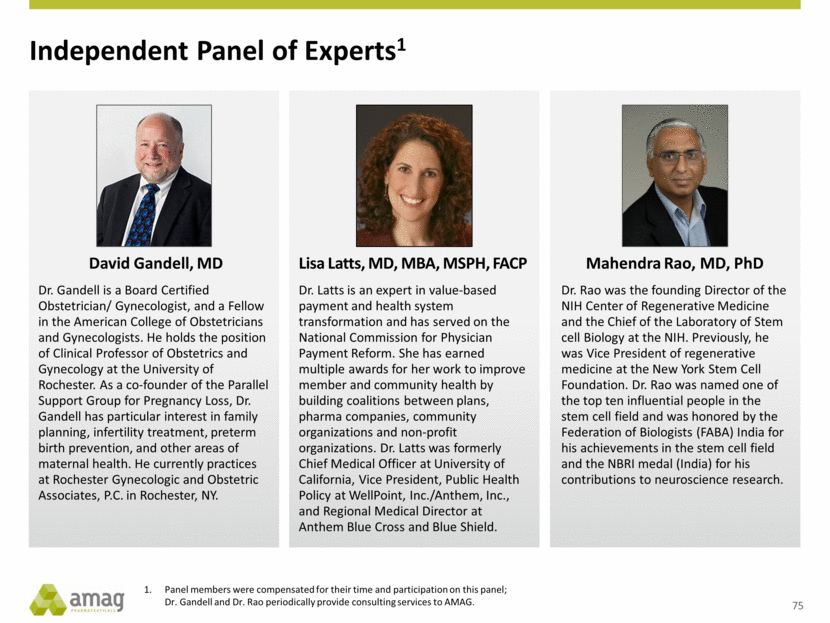
Feraheme Commercial Strategy & Outlook Nik Grund Chief Commercial Officer AMAG Analyst Day 2016
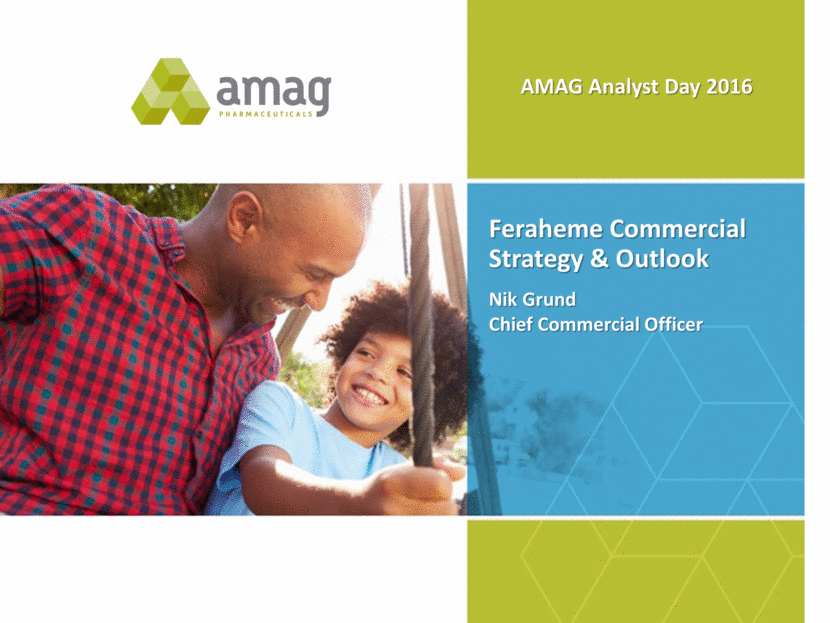
Feraheme Agenda Status Today Competitive Landscape Next Generation Development Market Opportunities 77

Feraheme: It’s as Easy as 1-2-3 1 gram 2 doses 3 days apart Why iron therapy is important Iron is a critical factor in the production of red blood cells 4.5 million Americans diagnosed and suffering from IDA2 Daily oral iron is first line therapy for most IDA patients Many patients fail oral iron therapy – compliance, efficacy and/ or side effects (constipation, GI upset) Attribute Feraheme 1 gram Dose1 Dosing1 Schedule: 2 x 510 mg doses Delivery: IV infusion Regimen (1 g): 2 treatments, 3 to 8 days apart Observation Period: 30 minutes post dosing Feraheme Used for the treatment of iron deficiency anemia (IDA) in adult patients with chronic kidney disease (CKD) 78 One gram of IV iron is the usual therapeutic course and that which was studied in the Feraheme clinical trials. Global Intravenous (I.V.) Iron Drugs Market Report: 2015 Edition.

Record Sales in Q1-2016 +13% Growth from volume +7% and price +6% Feraheme Sales Growth (GAAP) Breakdown of Feraheme Sales Q1-2016 Hem/Onc Segment 49% Hospital Segment 51% 79 $21.5 $24.2 1Q-2015 1Q-2016

Feraheme Agenda Status Today Competitive Landscape Next Generation Development Market Opportunities 80

Venofer® Iron Dextran/ Dexferrum 13.9% 40.2% 13.5% 18.1% Injectafer® Differentiated Product with Unique Positioning Ferric Gluconate2 14.3% 2015 U.S. share of non-dialysis IV iron market: ~1M grams1 81 IMS DDD Data through week ending 01/01/2016 Aggregate of Ferrlecit® Brand + Generic Ferric Gluconate

Feraheme Strong Pricing & Contracting Strategy Effective Quarter Quarterly History of Published Feraheme Payment Allowance Limit Allocation of Feraheme Volume by Contract Segment 94% of Feraheme Volume is Contracted Source: AMAG sales/chargebacks from 3Q15-1Q16 Source: https://www.cms.gov/Medicare/Medicare-Fee-for-Service-Part-B-Drugs/McrPartBDrugAvgSalesPrice/index.html. 82 Hospital Segment 48% Hem/Onc Segment 42% 6% 4% Not contracted Contracted Other 3Q09 1Q10 3Q10 1Q11 3Q11 1Q12 3Q12 1Q13 3Q13 1Q14 3Q14 1Q15 3Q15 1Q16

Multiple Causes of Iron Deficiency Anemia: Potential for Synergies with AMAG’s Two Sales Forces Anemia Gastrointestinal Inflammation Abnormal Uterine Bleeding Post OP Blood Loss Chronic Kidney Disease1 Malignancies/ Chemotherapy (Internists) (Internists) (Nephrologists) (Hematologists/oncologists) (OB/GYNs) (Gastroenterologist) AMAG existing sales force - synergy Approved indication. 83

Feraheme Agenda Status Today Competitive Landscape Next Generation Development Market Opportunities 84

Phase 3 Label Expansion Trial Underway Sample Size (N) N = 2,000 Main Study Key Entry Criteria Subjects with IDA and in whom intravenous iron treatment is indicated and have failed previous course of oral iron Primary Endpoint Safety Incidence of moderate to severe hypersensitivity reactions, including anaphylaxis, and moderate to severe hypotension Secondary Endpoint Efficacy Mean change in hemoglobin from baseline to week 5 Mean change in hemoglobin/mg iron delivered # Sites/Region 200 Sites, International (US, Canada, Europe) Randomized, Multicenter, Double-Blind, Safety Study of Ferumoxytol Compared to FerrIc Carboxymaltose for the TReatment of Iron Deficiency AneMia (IDA) (FIRM) 85

Head-to-Head Trial Design Ferumoxytol IV dosed 2 x 510 mg (Day 1 & Day 8) Injectafer IV dosed 2 X 750 mg (Day 1 & Day 8) Ferumoxytol N = 1000 N = 1000 Informed Consent & Screen Ferric carboxymaltose Head-to-Head N=2,000 5-week follow-up 5-week follow-up Randomize 1:1 86

2016 2017 2018 Estimated Timeline to Market Targeted FDA Approval First patient Enrollment Filing Feb. 87

Feraheme Agenda Status Today Competitive Landscape Next Generation Development Market Opportunities 88

Rationale for Injectafer as the Comparator Competitor with a broader label Similar dosing regimen allows for blinded study Injectafer requires 50% higher iron dose to achieve similar rise in hemoglobin levels More expensive than Feraheme Rationale 89

A CLOSER LOOK Large IV Iron Market Opportunity of $600M Feraheme 28% Other IV irons 72% Current Addressable Market: $300M1 Additional Addressable Market: $300M2 Iron deficiency anemia caused by other diseases – Iron deficiency anemia caused by Chronic Kidney Disease Label expansion doubles our addressable market3 Non-dialysis IV iron market AMAG estimates market opportunity using ~$600/gram. 1Q-2016 IMS Health data annualized. If regulatory approval is received for broad IDA indication. 90

A CLOSER LOOK IV Iron Market Represents Small Subset of 4.5M Patients Who Suffer from IDA 4.5M Total Patients Diagnosed with Iron Deficiency Anemia1 IDA-CKD Patients Majority under the care of current AMAG call points; hematology / oncology & hospital infusion centers Opportunity to convert from oral to IV treatments Diagnosed IDA Patients Under the care of other physician specialists, including OB/GYNs 28% 72% Other IV Label expansion doubles our addressable market3 600,000 IV Patients 91 Global Intravenous (I.V.) Iron Drugs Market Report: 2015 Edition.
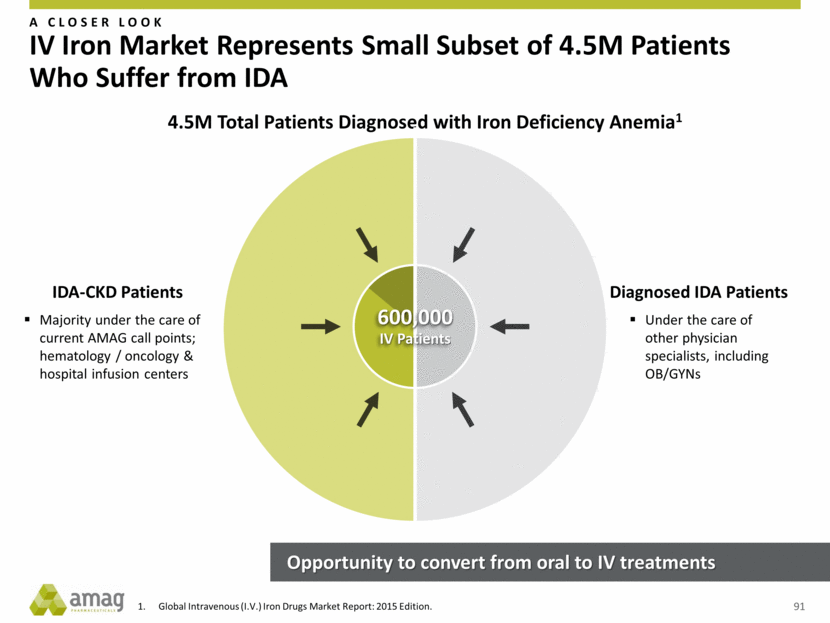
Future Growth: Potential to Double Size of Addressable Market Grow share in hospital segment Maximize opportunity in Hem/Onc segment Continue to gain share Growth Drivers Next 2-3 Years Label expansion – iron deficiency all cause Initiated Phase 3 trial Q1-2016 vs. Injectafer Potential approval 20181 Doubles addressable market to $600M Future IV iron market expansion opportunities Growth Beyond 2018 If regulatory approval is received for broad IDA indication. 92

IN SUMMARY Feraheme Franchise is Strong and Growing Overall IV iron market is growing double digits (+13% in 2015) Differentiated IV iron replacement therapy Clinical trial offers opportunity to show similar safety profile and equivalent efficacy with lower dose Label expansion provides opportunity to double size of Feraheme addressable market 93

Feraheme Q&A

Business Development Frank Thomas President & Chief Operating Officer

THE AMAG STORY – AGENDA Building a Growth-Oriented Biopharma Company AMAG Today Two Strong Platforms Multiple Growth Drivers 96

GOING FORWARD Multiple, Growing Revenue Streams Business Development Feraheme & MuGard CBR Makena Time 97 Velo $

Recent Transactions Fit Our Criteria Fits with core platforms Differentiated assets with growth potential Potential to add value, enhance growth Strong ROI, accretive Long-life assets 5+ years (with Makena next generation dev. program) Unmet medical need ü ü ü ü ü ü ü ü ü ü ü ü ü ü Velo Option ü 98

Building Our Portfolio: Search and Evaluate Criteria Core therapeutic areas (TAs) (maternal health, hem/onc & select hospital) Adjacent TAs (women’s health, nephrology) Therapeutic Criteria Differentiated & durable Stage of development Cash payback period and IRR Financial Criteria Physician relationships Commercial execution skills Consumer/digital platform Leverage Core Capabilities 99

~7,500 Products Initial Product Database Marketed Products: Branded products Unique Branded Generics Pipeline Products: Phase 2 or later Product Database Indication Fit Screened products, relevant indications for each target market ~2,000 Products Indication Fit Prioritized List Prioritized List Prioritized products based on several key factors such as indication, validated mechanism, stage of development and clinical need and market size ~180 Products Asset Screening Process Resulted in a List of 180 Prioritized Products 5-10 active 100

Example of How We Expand the Search Criteria Across the Continuum of Care in Women’s Health Current Bull’s Eye Decision to Get Pregnant Contraception Prenatal Vitamins Infertility Maternal Health Preterm Birth Placenta Disorders Labor Induction Preeclampsia Maternal Vitamins Birth / Post Birth Umbilical cord dermatitis Postpartum Hemorrhage Postpartum depression Nutrition Women’s Wellness Endometriosis Human papillomavirus Migraine Vaginal/Yeast infections Contraception Post Menopausal Hot flashes Vulvar and vaginal atrophy Female sexual dysfunction Osteoporosis 101

Portfolio Expansion: Leverage Expertise – Acquire Products/Companies with Durable Growth Opportunities Strong Financial profile, management team & corporate infrastructure FUTURE PRODUCT Maternal Health Hematology/Oncology, Nephrology & Hospital Consumer marketing expertise FUTURE PRODUCT CBR Commercial Expertise Makena® Velo Option Feraheme® MuGard® FUTURE PRODUCT New Therapeutic Area 102

In Summary Disciplined Criteria, Multiple Growth Opportunities Our recent acquisitions meet our criteria for long-term success Our evaluation approach focuses on therapeutic and financial fit within our portfolio, leveraging our core capabilities Focus on continuum of care for our patients allows us to examine products in adjacent areas of interest There are a number of attractive commercial and late-stage development assets on our prioritized target list 103

Financial Strategy & Guidance Ted Myles Chief Financial Officer

Agenda A Transformed Business: Delivering Top- and Bottom-Line Growth Well Positioned for Future Value Creation 105

A Transformed, Diversified, and Growing Revenue Profile 20162 Total Revenue Guidance $520M-$570M 20151 Total Revenue $418M 2014 Total Revenue $124M 2013 Total Revenue $81M Feraheme Feraheme Feraheme Feraheme Makena Makena Makena CBR CBR AMAG’s transition from one to multiple products has improved its ability to generate consistent cash flow. 106 Includes approximately $19M of purchase accounting adjustments related to CBR deferred revenue. CBR was acquired in August 2015. Includes approximately $17M of purchase accounting adjustments related to CBR deferred revenue. See slide 126 for an explanation of CBR deferred revenue adjustments. CBR was acquired in August 2015.

Cash Earnings in Excess of $200M Expected in 2016 Non-GAAP Cash Earnings ($M) AMAG’s strong cash generation creates flexibility, even in challenging capital markets 2 107 GAAP net income. See slides 124-125 for a reconciliation of GAAP to non-GAAP financial information. See slide 123 for a reconciliation of GAAP to non-GAAP financial guidance information. 3 2 1 ($9.6) $7.7 $173.7 2013 2014 2015 2016 Guidance $195 - $225

2016 Financial Guidance Makena sales $251.6 $310-$340 +29% Feraheme and MuGard sales $90.2 $95-$105 +11% Cord Blood Registry revenue $118.64 $115-$1255 +1% Total Non-GAAP revenue $397.4 $520-$570 +42% Non-GAAP Adjusted EBITDA $213.4 $255-$285 +27% Non-GAAP cash earnings $173.7 $195-$225 +21% 2015 Actual1 2016 Guidance2 Increase vs. 20153 $M 108 See slides 124-125 for a reconciliation of GAAP to non-GAAP financial information. See slide 123 for a reconciliation of GAAP to non-GAAP financial guidance. Reflects midpoint of guidance. Includes approximately $22M of purchase accounting adjustments related to CBR deferred revenue. Revenues shown are pro forma for 2015 and assume CBR was acquired at the beginning of 2015. CBR was acquired in August 2015. Includes approximately $17M of purchase accounting adjustments related to CBR deferred revenue. See slide 126 for an explanation of CBR deferred revenue adjustments. CBR was acquired in August 2015.

Agenda A Transformed Business: Delivering Top- and Bottom-Line Growth Well Positioned for Future Value Creation 109

Capital Allocation Principles Focus on Shareholder Returns 3 Strong cash position allows us to pursue our strategy, even in challenging markets Full commitment to value-creating opportunities that we choose to pursue: organic or external Key criterion in making investment decisions Conviction to Investments 2 Liquidity 1 110
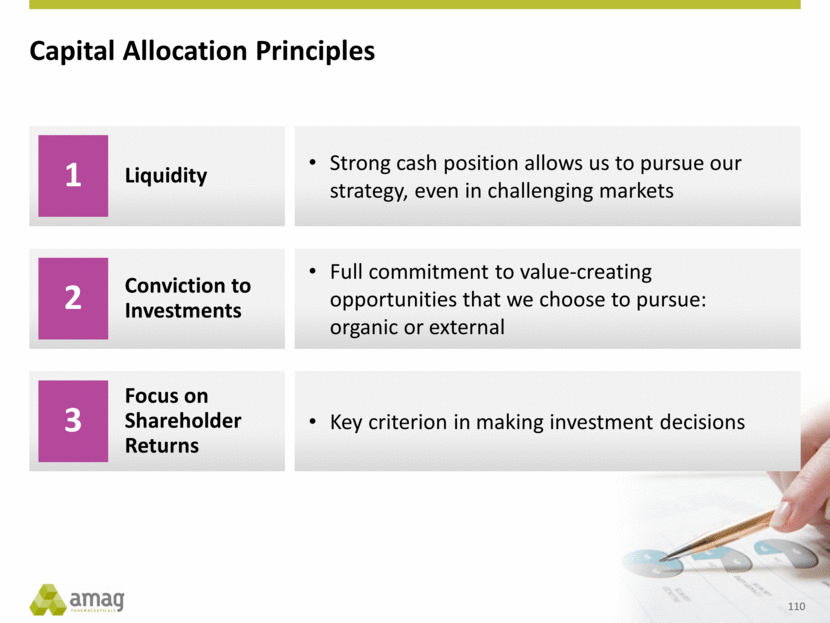
Evaluating our Capitalization Against a Wide Range of Opportunities for Value Creation in the Near and Intermediate Term ($M, as of March 31, 2016) Cash and investments $480 Debt Convertible senior notes (2.5%) $200 Term loan facility (4.75%) $341 2023 senior notes (7.875%) $500 Total debt (principal amount outstanding) $1,041 Market capitalization (34.6 million shares) $809 Expect to generate ~$200M cash flow in 20161 111 1. Excludes $100M sales milestone expected to be paid by AMAG to former shareholders of Lumara Health.

112 Current Debt Balance is Manageable and Well within AMAG Peer Group Sources: Company filings, Wall Street Research and Capital IQ as of May 25, 2016. 1. PCRX, ACOR, SUPN and INSY all have cash balances that exceed total debt. 2. Not meaningful (“nm”) due to negative EBITDA. 2 1 1 1 1 Comparable Companies Median: 5.4x total / 5.2x net Debt / LTM EBITDA Total debt / LTM EBITDA Net debt / LTM EBITDA

AMAG Share Price Not Reflective of True Value of Company NTM EBITDA Multiple NTM Revenue Multiple Specialty Pharma2 (47.9%) BTK1 (14.4%) S&P 500 3.9% 2 2 Source: Capital IQ as of May 25, 2016. NYSE Arca Biotechnology Index. Spec Pharma index includes Acorda, AMAG, Concordia, Depomed, Endo, Horizon, Insys, Ironwood, Jazz, Mallinckrodt, Pacira, Supernus and Valeant. 113 0% 20% 40% 60% 80% 100% 120% Jan-16 Feb-16 Mar-16 Apr-16 May-16 2.2x 4.1x AMAG Specialty Pharma 3.9x 11.1x AMAG Specialty Pharma

Current Cash Balance and Projected Cash Flow Provides Capacity for Transactions $M Cash and investments – December 31, 2015 $467 2016 cash earnings guidance1 $195 - $225 With existing balance and expected near-term generation of cash, deals can be completed without issuing debt or equity. 2016 financial guidance does not account for $100M sales milestone payment expected to be paid in 2016 to former shareholders of Lumara Health, as well as working capital. 114

While AMAG Continues to be Discriminating in its Evaluation of BD Opportunities, Growth Exists within Current Portfolio Strong financial profile, management team & corporate infrastructure Commercial & Digital Expertise Maternal Health Hematology / Oncology, Nephrology & Hospital Future product CBR Makena® Velo option Feraheme® MuGard® New therapeutic area Future product Future product In addition to potential transactions, AMAG has several opportunities to create significant shareholder value within its current portfolio 115
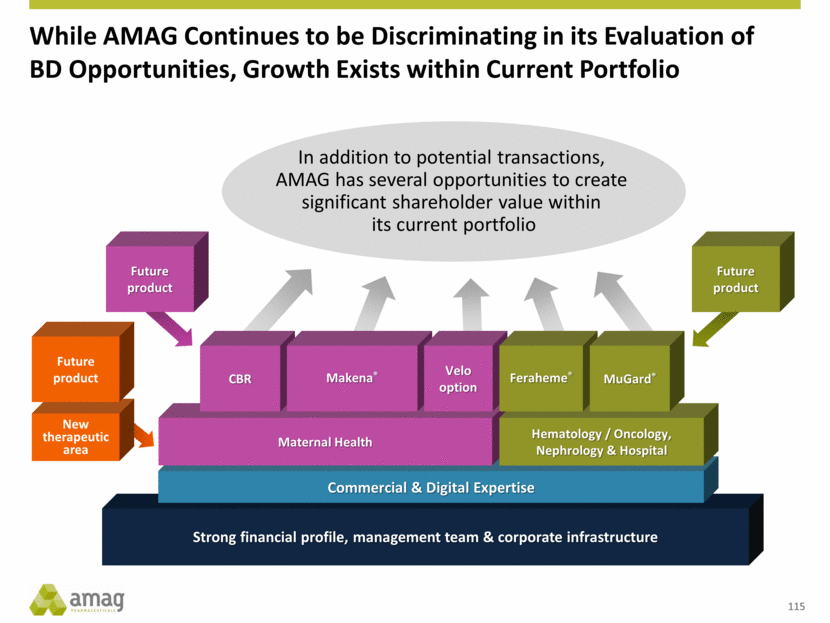
IN SUMMARY Near-Term Execution Creates Long-Term Opportunities Execution of our business plan in the near term expands opportunities for value creation in the long term. Cash Debt Equity Near-term At current levels, not inclined to issue equity Asset deals, structured licenses and options, and bolt-on acquisitions De-levering with existing cash flows Potential for highly accretive deals Excess cash sweep in term loan provides mechanism to de-lever balance sheet Longer-term As sector issues resolve AMAG’s next gen. programs progress Execution on plan Additional cash flow from operations Successful next gen. programs and return of equity and debt markets allow AMAG to utilize cash more aggressively Possible refinancing to support larger deal and/or lower cost of capital 116

Closing Remarks Bill Heiden Chief Executive Officer AMAG Analyst Day 2016

Key 2016 Milestones 2016 Commercial launch of single-dose, preservative-free formulation Initiate a pharmacokinetic study for the Makena subcutaneous auto-injector Initiate a head-to-head Phase 3 clinical trial in Q1 2016 evaluating the safety of Feraheme compared to Injectafer in adults with IDA Makena Feraheme Initiate stock re-purchase program Growing earnings and de-levering adds to borrowing capacity for acquisitions Financial Opportunities to further expand company’s product portfolio through acquisitions or in-licensing of products or companies Business Development 118

2017-2019 Key Milestones Ahead Launch Makena subcutaneous auto-injector1 Launch Feraheme with broad IDA indication1 Accelerate the addition of newly stored units to >750,000 cumulative units Phase 2b/3a data in preeclampsia for Velo product Further expand the company’s product portfolio through acquisitions or in-licensing of products or companies Makena Feraheme Velo Business Development If regulatory approval is obtained. 119 CBR

IN SUMMARY Building a Growth-Oriented Biopharma Company Transformed into growing, multi-product biopharmaceutical company Growing revenues of >$500M and profitable, while investing in existing & new product development opportunities Attractive near and longer term cash generation potential Maternal Health Makena – growing 29% in 2016 CBR – durable, recurring revenue stream Hem/Onc/Hosp Feraheme – steady and consistent growth with upside potential Makena Single dose vial Subcutaneous auto-injector CBR Market segmentation & pricing opportunities Direct-to-consumer platform Feraheme IDA broad indication New growth opportunities Through acquisition of commercial or late-stage development products AMAG Today Two Strong Platforms Multiple Growth Drivers 120

Q&A AMAG Analyst Day 2016

Appendix AMAG Analyst Day 2016

Adjusted EBITDA and Cash Earnings Reconciliation ($M) 2015 2016 Guidance GAAP Net income $32.8 $11 - $41 CBR deferred revenue purchase accounting adjustments 19.1 17 Depreciation & amortization 57.5 90 Interest expense, net 71.4 72 Provision for income taxes 7.1 20 EBITDA $187.9 $210 - $240 Non-cash collaboration revenue (40.0) NA Non-cash inventory step-up 13.7 5 Stock-based compensation 17.2 27 Adjustment to contingent consideration 4.3 12 Severance & transaction related costs 20.3 1 Velo option 10.0 NA Adjusted EBITDA $213.4 $255 - $285 Cash interest expense (39.7) (60) Cash earnings $173.7 $195 - $225 123

GAAP to Non-GAAP Financials for the Years Ended December 31, 2015 and 2014 124 Twelve Months Ended Twelve Months Ended December 31, 2015 December 31, 2014 GAAP Adjustments Non - GAAP GAAP Adjustments Non - GAAP Revenues: Makena $ 251,615 $ — $ 251, 615 $ 22,513 $ — $ 22,513 Feraheme/MuGard 90,201 — 90,201 87,485 — 87,485 Cord Blood Registry 24,132 19,136 1 43,268 — — — License fee, collaboration and other revenues 52,328 (39,965) 2 12,363 14,386 (8,217) 2 6,169 Total revenues 418,276 (20,829) 397,447 124,384 (8,217) 116,167 Operating costs and expenses: Cost of products sold 78,509 (64,536) 3 13,973 20,306 (6,706) 3 13,600 Cost of services 9,992 (1,563) 4 8,429 — — — Research and development 42,878 (14,258) 5 28,620 24,160 (1,662) 5 22,498 Selling, general and administrative 160,309 (27,324) 6 132,985 72,254 (6,534) 6 65,720 Acquisition - related 11,232 (11,232) 7 — 9,478 (9,478) 7 — Restructuring 4,136 (4,136) 8 — 2,023 (2,023) 8 — Total costs and expenses 307,056 (123,049) 184,007 128,221 (26,403) 101,818 Operating income (loss) / adjusted EBITDA 111,220 102,220 213,440 (3,837) 18,186 14,349 Other income (expense): — Interest expense (53,251) 12,041 9 (4 1,210) (14,697) 6,967 9 (7,730) Loss on debt extinguishment (10,449) 10,449 10 — — — — Interest and dividend income, net 1,512 — 1,512 975 (17) 958 Other income, net (9,188) 9,185 1 0 (3) 217 (103) 114 Total other income (expense) (71,376) 31,675 (39,701) (13,505) 6,847 (6,658) Net income (loss) before income taxes 39,844 133,895 173,739 (17,342) 25,033 7,691 Income tax expense (benefit) 7,065 (7,065) 1 1 — (153,159) 153,159 1 1 — Net income (loss) / cash earnings $ 32,779 $ 140,960 $ 173,739 $ 135,817 $ (128,126) $ 7,691 Net income (loss) / cash earnings per share B asic $ 1.04 — $ 5.52 $ 6.06 — $ 0.34 Diluted $ 0.93 — $ 4.43 $ 5.45 — $ 0.30 Weighted average shares outstanding Basic 31,471 — 31,471 22,416 — 22,416 Diluted 35,308 — 3 9,211 25,225 — 25,225

125 GAAP to Non-GAAP Financials for the Year Ended December 31, 2015 Adding back period write-down of deferred revenue from purchase accounting. Eliminate non-cash revenue related to recognition of previously deferred revenue on Takeda agreement. Eliminate the following: (i) non-cash step-up of inventory from purchase accounting; (ii) amortization expense related to intangible assets; (iii) depreciation expense; and (iv) stock-based compensation expense. Eliminate the following: (i) depreciation expense; and (ii) certain non-recurring inventory reserves. Eliminate the following: (i) non-cash step-up of inventory used in research and development from purchase accounting; (ii) depreciation expense; and (iii) stock-based compensation expense. Eliminating the following: (i) non-cash adjustments related to contingent consideration; (ii) amortization expense related to intangible assets; (iii) certain transaction-related expenses; (iv) depreciation expense; and (v) stock-based compensation expense. Eliminate non-recurring acquisition costs. Eliminate non-recurring restructuring costs. Eliminate non-cash interest expense; amortization of debt discount and other non-cash costs. Eliminate non-cash or other non-recurring expenses related to the August 2015 term loan financing. Eliminate non-cash income tax.

CBR Non-GAAP Revenue Adjustment Deferred revenue balance on August 17, 2015 Addback to calculate non-GAAP revenue to be reported in future periods ($M) Purchase accounting rules require write-down of closing date deferred revenue on balance sheet at acquisition date Reflects the GAAP balance sheet adjustment following the 2015 acquisition of CBR by AMAG; prior adjustment due to 2012 acquisition of CBR by GTCR. Write-Off amount is added back in the period it would have been recognized in to arrive at non-GAAP revenue. Reflects the addbacks from both the 2015 acquisition of CBR by AMAG and the 2012 acquisition of CBR by GTCR. ($M) 1 2 3 126 $3.1 $58.8 $0 $10 $20 $30 $40 $50 $60 $70 Closing Date GAAP Write-Off Amount $17.0 $5.5 $5.4 $5.3 $55.4 $0 $10 $20 $30 $40 $50 2016 2017 2018 2019 2020-2078 Non-GAAP Addback
